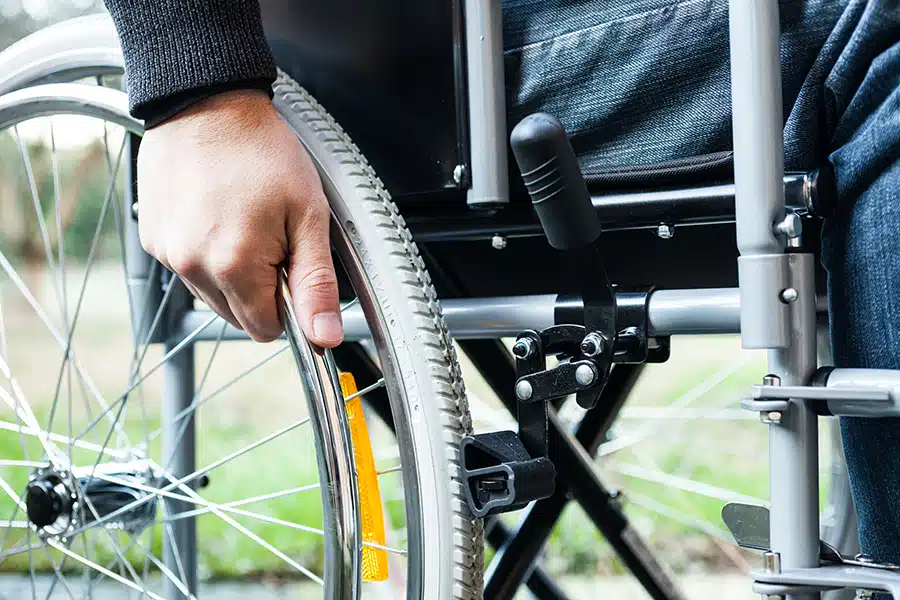Emery | Reddy, PLLC: L&I FAQ
On-the-job injuries or occupational illnesses can seriously upend a worker’s life, forcing them to take weeks, months, or sometimes even years off work while costly medical bills pile up. In Washington state, the Department of Labor and Industries (L&I) administers its own workers’ compensation L&I benefits, either through a public State Fund (covering two-thirds of Washington state workers) or through self-insured employers (covering one-third of Washington state workers).
But what, exactly, is L&I? How does the L&I claim process work? And, how much could you be awarded?
Most people suffering from a work-related injury or an occupational illness have similar questions, and the experienced Seattle L&I Attorneys at Emery | Reddy have answers! Read more to learn the answers to some of the most common workers’ comp and L&I questions that we hear from injured workers.
What Is L&I?
L&I is a government agency in Washington state that handles workers’ compensation claims and provides medical benefits and limited wage-replacement coverage to workers who are injured or develop certain occupational illnesses at work. Essentially, L&I functions like a State-run insurance company. Like an insurance company, L&I decides which claims to pay and makes those payments.
How Does L&I Work?
When you get hurt or contract certain types of illnesses at work, you are entitled to workers’ compensation benefits. In Washington state, you can file an L&I claim through their website via the File Fast tool, by calling the L&I office at 877.561.3453, or at your doctor’s office. If all goes as planned, your claim will be accepted, and you will receive the benefits to which you are entitled.

What Benefits Does L&I Provide?
- Claim resolution settlement agreements (CRSAs)
- Death benefits
- Firefighter benefits
- L&I disability pensions
- Loss of earning power (LEP) benefits
- Medical benefits
- Permanent partial disability (PPD) awards
- Property damage reimbursement
- Seattle Paid Sick and Safe Time (PSST)
- Time-loss
- Travel reimbursement
- Vocational rehabilitation
How Does the L&I Claims Process Work?
The L&I claims process can be extremely complex and time-consuming, even when you’re not the ill or injured party. Follow the steps below to ensure that your L&I claim is closed quickly and in your best interests:
- File your claim: You can file your claim on the L&I website via the File Fast tool, by calling the L&I office at 877.561.3453, or at your doctor’s office.
- Receive your benefits: You will receive the L&I benefits to which you are entitled.
- Complete an Independent Medical Examination (IME) if requested: An IME is conducted by an approved L&I provider if requested by your L&I Claims Manager. Your injury will be rated and you will receive benefits according to that rating.
- Close your claim: Your L&I claim will close when you have met maximum medical improvement (MMI) and your treatment is successful and complete.
- Reopen your claim: If your workplace injury or occupational illness worsens, you and your doctor may apply to reopen your claim.
- Appeal or protest denied claims: If your claim is denied, you, your employer, and your doctor all have the right to protest or appeal the denial. You have the right to do so with any decision made about your workers’ compensation L&I claim.
Why Are L&I Claims Denied?
L&I workers’ compensation claims are denied for any number of reasons, such as missed deadlines or disputes about whether the injury was work-related. It takes experience and persistence to get L&I to reverse a denied workers’ comp claim. Common reasons for claim denials include the following:
- The injury is considered preexisting and was not worsened by an industrial injury or occupational illness.
- The injury is determined to have occurred outside of work.
- The injury occurred in a parking lot, which means it is not covered.
- The injury is a mental health condition and is denied due to a lack of objective medical evidence.
- An Independent Medical Exam (IME) diagnosis determines the injury is not as bad as claimed or even non-existent.
L&I Claims Managers often make mistakes: Sometimes L&I Claims Managers miss critical evidence or choose not to believe the evidence with which they are presented. They can also have personal biases, opinions, and belief systems that make them ineffectual in deciding to allow a given claim. There are even examples of some L&I Claims Managers misunderstanding an injured worker’s mental health issues or misreading key medical files. When these mistakes are made, they must be corrected.
Doctors make mistakes: Mistakes happen, especially by Independent Medical Examiners who work for L&I. They sometimes misdiagnose a patient, apply an incorrect category rating, or mischaracterize a workplace injury as one that is preexisting or occurred outside of work. Sometimes they fail to put the correct language into a medical report, which renders it useless as legal evidence. And sometimes they don’t understand or believe the amount of pain the injured worker is experiencing. This happens frequently, especially when an IME is involved.
Employers also make mistakes: Sometimes they believe that an injured worker was hurt outside of work, especially if they didn’t witness the injury. Sometimes they don’t understand or believe that their workplace could cause a mental health issue. Sometimes they don’t agree that the workplace is harmful enough to cause occupational illness.
Can I Choose Any Doctor I Want?
In Washington state, your Independent Medical Exam (IME) must be provided by an L&I-approved provider. These providers are seen as experts, and their opinions are given significant weight — so the doctor chosen as your Attending Provider (AP) will greatly influence your case.
Seek counsel from an experienced L&I attorney if you feel like your L&I-approved provider is not supportive. APs work closely with L&I and their medical opinions often reflect that biased relationship.
How to File an L&I Claim in Washington State
In order to receive benefits from L&I there are two very important things that you must do right away, even before a claim is filed:
- Get medical help.
- Tell your employer.
If you are injured at work, you have three options to file a Washington state L&I claim:
- File by phone at 877.561.3453.
- File online through the L&I website’s File Fast tool.
- File at your doctor’s office.
Note that if you work with a self-insured employer, you must file your claim with them.
To file an L&I claim in Washington state, you must provide the following:
- The location where the injury occurred
- Contact information for any witnesses to the injury
- Employer information
- Wage information
- If you have already seen a doctor:
- Your doctor’s first and last name
- The hospital or clinic where you received treatment
Note that if you work with a self-insured employer, you must file your claim with them.
If you are eligible for time-loss, and no further information is needed, L&I or your self-insured employer will send the first benefit check within 14 days of receiving the report. If your doctor is one of the many healthcare providers that do not handle workers’ compensation claim cases, you can find an L&I-approved doctor on the L&I website. If your L&I claim is approved, L&I will cover the initial visit even if it wasn’t with one of their approved doctors.
L&I or your self-insured employer must receive your Report of Accident within 1 year of your injury date to file a claim. Occupational illness claims must be received within 2 years from the date that your doctor notifies you in writing that your injury is work-related.
HOW IT WORKS
Watch This Video to Learn More About the Workers’ Comp Claim Process
Are L&I Workers’ Compensation Benefits Taxable?
No. The IRS considers time-loss compensation and other awards for your injury to be a disability benefit, not earned income, so income tax laws do not apply.
Additionally, Washington State tax does not apply to workers’ compensation benefits. You will not receive a W-2 or any tax notification documents.
However, if you are receiving workers’ compensation L&I benefits as well as Social Security disability income, there may be a tax notification.
What Is the Statute of Limitations (SOL) for L&I?
A statute of limitations (SOL) is a time limit that determines how long you have to make a claim to gain compensation for various injuries, such as personal injuries and workplace injuries. In Washington state, L&I or your self-insured employer (SIE) must receive your Report of Accident within 1 year of your injury date to file a claim. Occupational illness claims must be received within two years from the date that your doctor notifies you in writing that your injury is work-related.
Don’t leave it until the last minute to file your L&I claim. Call a Seattle L&I attorney as soon as possible to make sure you don’t run out of time.

What Is an L&I Settlement or Award?
To determine the value of your L&I settlement or award, you first need to understand the different types of workers’ compensation offered in Washington state. L&I settlements and awards are paid out once the claim is closed, though the total settlement or award amount paid upon claim closure depends on the size. L&I settlement and award amounts vary widely and typically fall into three categories:
1. L&I disability pension: A life-long benefit awarded to injured workers who will never be able to return to any gainful employment due to a severe or life-threatening injury.
2. Permanent partial disability (PPD) award: A one-time sum paid to injured workers when their L&I claim is closed. The worker can re-enter the workforce following a PPD award.
3. Claim resolution settlement agreement (CRSA): An L&I settlement option where all parties agree to close an injury claim for a specified amount. When agreeing to this settlement type, the injured worker exchanges all future benefits, except medical, for the payment.
How Can I Check My L&I Claim Status?
To check on your L&I claim status, you must contact L&I via the L&I Claim and Account Center or call the claim information hotline at 800.831.5227. Be sure to have your claim number readily available.
Is L&I Insurance the Same as Workers’ Compensation?
While L&I is the primary form of workers’ compensation in Washington state, it is not the only option. Employers can pay for their own self-insurance if they meet certain requirements. Regardless of your coverage, your worker’s rights to L&I benefits will not change. However, the management of your claim will differ. If your coverage is through self-insurance, you will have to go through your employer rather than L&I to complete your workers’ compensation claim and receive your benefits.
What Is an L&I Disability Pension?
An L&I disability pension is a special category of pension only awarded to the most severely injured workers. If you are eligible for an L&I disability pension, you will receive a non-taxable payment every month for the rest of your life.
Under Washington state law (WAC 296-14-150), gainful employment is defined as a regular occupation (in any position) for income, salary, or wages. If your doctor or Vocational Counselor says that you cannot ever work again because of a job-related injury or illness, you may be entitled to Washington State Labor and Industries pension benefits.
It’s not easy to be granted an L&I disability pension — you must be committed to the process. As these lifetime benefits are so valuable, the system is set up to derail your claim at every step along the way.
The process involves complicated bureaucratic hurdles and red tape, along with consultations with L&I Claims Managers, employers, Vocational Counselors, and Independent Medical Examiners who do not always have your best interests in mind. These parties have blocked many workers before you and will try to stop you from securing an L&I pension. An experienced L&I attorney with a proven track record of avoiding those traps is your best bet for successfully navigating the system.
HOW IT WORKS
Watch This Video to Learn More About L&I Disability Pensions
How Do I Qualify for a Washington State L&I Disability Pension?
You may receive a monthly L&I disability pension if you are certified as permanently and totally disabled, AND:
- The medical and vocational evidence finds that your injury prevents you from becoming gainfully employed, OR
- You have lost, or lose the use of, both legs, both arms, an arm and a leg, or your vision.

If I Qualify, Can I Increase My Chances of Receiving an L&I Disability Pension?
You can increase your chances of receiving L&I disability benefits. By obtaining a favorable medical opinion and showing what you have done to help yourself so far, you can provide the necessary information needed to prove your claim.
There are also factors — specific to only you — such as your age, education, and work experience that can be helpful in increasing your chances of receiving an L&I disability pension.
- Age: Being more advanced in age is beneficial to your claim. The older you are, the less chance you have of being able to learn a new skill or job.
- Education: The less education you have, the better for obtaining a pension. Without a degree, you do not have certain qualifications employers seek during the rehiring process.
- Work experience: A smaller amount of work experience rather than a long-term career shows that you do not have as many transferable skills.
What Is Permanent Partial Disability (PPD)?
In Washington state, permanent partial disability (PPD) is broadly defined as a physical or mental impairment arising from an injury that is fixed, lasting, stable, and can’t be improved with further medical treatment. When your injury can be classified as a permanent partial disability, you are entitled to workers’ comp permanent partial disability benefits and compensation for damages.
Common Injuries Cause Permanent Partial Disability
There are many common workplace injuries that could lead to PPD, including:
- Amputation,
- Back injury,
- Cardiovascular or respiratory disease,
- Depression,
- Hearing or vision loss,,
- Knee injury,
- Musculoskeletal disorders,
- Post-traumatic stress disorder (PTSD), and
- Shoulder Injury.
How Are Permanent Partial Disability Awards Paid?
PPD awards are based on the type of injury and the level of severity of the injury and are measured by an impairment rating calculated with the L&I PPD Awards Charts. In general, the higher the rating, the bigger the payout. An experienced L&I lawyer and the right doctor are usually the winning combination to unlocking the maximum amount of L&I benefits to which you are entitled.
- Permanent partial disability in Washington state is calculated when L&I closes your claim.
- Your impairment is rated by a doctor or your attending physician during a PPD rating exam, followed by an approved L&I doctor during an Independent Medical Exam (IME) once you have reached maximum medical improvement (MMI).
- You will receive your award after you get medical care for your injury, become employable, get a rating exam, and have your claim closed by L&I.
- If the award amount is less than three times the state’s average monthly wage at the date of injury, L&I or the self-insured-employer (SIE) sends a check for that amount.
- If the award exceeds more than three times the state’s average monthly wage at the date of injury, L&I or the SIE makes a down payment. They then pay the balance of the award once a month in installments equal to the worker’s monthly time-loss compensation (at the time of closure).
Do Temporary Workers Get L&I Benefits?
Under Washington state’s L&I laws, it doesn’t matter whether you’re a temporary or permanent worker — if you’re injured on the job, you may be eligible for L&I benefits. Even if you were recruited by another agency and ended up working temporarily for a third party, you can file an L&I claim with the employment agency instead of the place of business where the injury occurred.
Third-Party Claims
If injured by a third party in Washington state, workers cannot sue their employer for compensation. However, when injuries are caused by defective products or machinery, or by someone who is not a co-worker, you may be able to file a third-party claim to cover the costs of your injury.
What Is a Third-Party Claim?
A third-party claim is one in which someone other than your employer or co-worker is responsible for your injury. If you have been injured on the job due to someone else’s actions or negligence, you may be entitled to additional compensation through a third-party claim, which combines your L&I claim with a personal injury claim using the same facts.
Unlike workers’ compensation payments, there is no limit to the amount of compensation an injured worker may seek in third-party damages. Third-party claims are private matters and are typically litigated directly with the Washington State Superior Court.
Who Is at Fault for a Workplace Injury?
L&I is a no-fault system, ensuring compensation for any workplace injury. However, if a third party is involved in causing the injury, you may be able to pursue legal action against them for additional compensation under third-party claims.
Can I Hire an Attorney to Represent Me for a Workers’ Compensation L&I Claim?
All Washington state workers have the right to be represented by an attorney in a workers’ compensation claim. If your injury prevents you from doing significant parts of your job or makes it difficult to work, an L&I attorney can be very helpful in advocating for the full amount of benefits to which you are entitled based on your injury’s severity.
You may need a workers’ compensation attorney if:
- You or your loved one suffered a workplace injury or occupational illness.
- Your employer is not supportive of your L&I claim.
- Your workers’ compensation claim or benefits were denied.
When looking for a workers’ compensation attorney, make sure to find someone with a track record of positive results who can build a case and gather evidence to present your claim as effectively as possible.
Can I Get an Overpayment With L&I?
An L&I overpayment occurs when the insurance company pays you more than what they’re obligated to provide. This is often not the fault of the claimant, but rather due to clerical errors or incorrect data. In the case of willful misrepresentation by the claimant, L&I can demand repayment plus a 50% penalty.
What Does Overpayment Mean for You?
If you have received an overpayment from L&I, you will owe the overpayment amount back to them.
The insurance company will send a letter explaining what it is attempting to recover, how much you owe, and why it is making the attempt. You are entitled to an explanation of the insurance company’s reasoning for this offset and any other information on the overpayment or its status.
If you don’t repay the L&I overpayment, you could be sued by the insurer. Any judgment against you could result in a lien placed on your property and may be reported adversely to credit bureaus.

Can I Fight an L&I Decision?
You, your employer, and your doctor all have the right to protest any decision made about your workers’ compensation claim. L&I must receive a written protest within 60 calendar days of the date the decision was received (15 days for decisions about vocational benefits) or the decision will become final.
You may also appeal directly to the Board of Industrial Insurance Appeals (BIIA). The decision becomes final if your written appeal is not received within the following legal time limits from the date you received the decision:
- 60 days to appeal a claim decision or a payment decision
- 20 days for providers to appeal a billing decision that reduces the amount paid, or demands repayment
Your appeal must include the following:
- The injured worker’s name and claim number (make sure this information is on every page),
- The injured worker’s address,
- Date and description of the L&I claim or billing decision you are appealing,
- Reason(s) you disagree with the decision,
- Submitter’s name, mailing address, and telephone number,
- City in which you wish the proceedings to take place, and
- Supporting information you consider important.
How to Submit an Appeal
You can submit your appeal online, by mail, or in person.
By mail:
Board of Industrial Insurance Appeals
PO Box 42401
Olympia, WA 98504-2401
In-person:
Board of Industrial Insurance Appeals
2430 Chandler Court SW
Olympia, WA 98504
You may appeal directly to the Board of Industrial Insurance Appeals (BIIA) without first protesting to L&I. After receiving your appeal, the board will notify L&I and give them an opportunity to reconsider their original decision. If L&I does not reconsider its decision, the Board will schedule a hearing for your appeal.
If you have further questions regarding the appeal process, you can contact the BIIA at 360.753.6823 or 1.800.442.0447.
HOW IT WORKS
Watch This Video to Learn More About the Protest and Appeal Process
Can You File Both an L&I Claim and a Third-Party Claim?
L&I claims and third-party claims often go together, and injured workers often need to file both. An L&I claim will be filed with your doctor at your first medical visit regarding the injury. At a later date, if they suspect your case qualifies for a third-party claim, L&I will send you a Third-Party Election Form. Either you or your L&I lawyer will need to fill out this form and send it back within 60 days of receiving it.
Your third-party claim will pursue the money that L&I was unable to pay, allowing you to get money back for your pain and suffering, lost wages, and medical expenses, and even replace future earnings you may have lost if the injury has left you with less earning potential than before.
Both L&I and third-party claims can result in a cash settlement, but the payment from L&I is limited. By actively pursuing both an L&I claim and a third-party claim, you can ensure that you are fully and adequately compensated for your injury.
An L&I Claim and a Third-Party Claim Affect Each Other
- Third-party claims combine your L&I claim with your personal injury claim using the same facts.
- A third-party settlement will affect ongoing and future L&I benefits because L&I must be reimbursed from any recovery.
- L&I orders directly affect your third-party claim.
- A third-party claim can create a deficiency and ruin your L&I claim.
- A bad order or unfavorable Independent Medical Exam (IME) can hurt your third-party claim.
- An L&I claim can be limited or even denied by L&I or the self-insured employer thereby severely affecting the third-party recovery.
Will L&I Pay My Medical Bills?
It is important to understand that only certain medical conditions and treatments are covered by L&I. To qualify for medical benefits, your injury or illness must be work-related. Some of the reasons that you may not be entitled to workers comp medical benefits include the following:
- Medical conditions not related to your workplace injury or illness
- Treatment that cannot be measured objectively by a doctor
- Treatment that continues after the worker is medically stable
- Treatment from providers who are not enrolled in L&I’s network
Medical Benefits
In order to receive workers’ compensation medical benefits from L&I, there are two very important things that you must do right away, even before a claim is filed:
- Get medical help.
- Tell your employer.
L&I, or your self-insured employer (SIE), can approve your claim if your doctor certifies that you were the victim of a workplace injury or have an occupational illness. If your claim is approved, you may be eligible for medical benefits.
Workers’ comp medical benefits will be available to you for as long as your claim is open, even if you have returned to work. Your first visit to a doctor for a workplace injury is covered by L&I, even if your claim is not approved. If you need medical care after the first visit, you will need to see an approved provider in the L&I network.
Sometimes, workers who feel they have fully recovered will later find that they still need additional medical care for the same ongoing injury. If your claim was closed prematurely and you need further compensation, our Seattle L&I Attorneys can work to reopen your case to ensure that any additional medical bills will be covered, including disability benefits.
Who Pays for L&I Medical Benefits?
L&I will pay for all medical bills that are directly related to the industrial injury. L&I will only pay for medical care that is related to your accepted workplace injury or occupational illness. Proper and necessary services may be either curative or rehabilitative.
- Curative treatment: Treatment provided to a patient with the goal of curing a workplace injury or occupational illness
- Rehabilitative treatment: Treatment intended to allow an injured or ill worker to regain or improve the abilities needed to get back to work
These benefits typically end when a workers’ comp claimant reaches maximum medical improvement (MMI) or when the claim closes.
Does Workers’ Compensation Pay for My Lost Wages?
Time-loss compensation, also known as wage replacement benefits, is a partial wage replacement for an L&I claim and is paid every two weeks while you are not working due to a job injury or an occupational illness. See RCW 51.08.178 & 51.32.090. In such cases, L&I will reimburse you for lost time and wages — typically between 60-75% of the worker’s earnings prior to the injury or illness up to a maximum cap. The IRS considers time-loss compensation to be a disability benefit, not earned income, so income tax laws do not apply.
One thing to note is that the first three days following your injury are considered a waiting period, and you won’t receive your wage replacement for those days until you’ve been out of work for at least 14 days after the injury.
What Benefits Does L&I Time-Loss Compensation Offer?
If you are approved for time-loss benefits, you may receive compensation for the following:
- Lost wages: The money you’ve lost from being unable to work
- Medical expenses: The cost of treatment required for your work-related injury
- Vocational rehabilitation: The cost of learning new skills that will help you find other employment within the workforce
How Much Does L&I Pay for Time-Loss?
Time Loss Calculator
Invalid input
Your estimated time-loss compensation is
*
*Time loss is subject to a maximum set by L&I and adjusted annually. This calculation is as of 2022. Call Emery Reddy to discuss your specific case.
Wage replacement payments will not be as much as your regular paycheck. Time-loss pays 60-75% of the wage you were earning before your injury. If you are already receiving time-loss, it is important to double-check the calculation as L&I often makes mistakes on wage orders, miscalculates rates, or fails to consider other income sources.
- Maximum time-loss rate: In Washington, the maximum L&I time-loss rate for 2024 is $8,250 per month, equivalent to 120% of the state’s average 2020 monthly wage. For details see L&I’s Maximum Time Loss Rate.
- Minimum time-loss rate: In 2024, the minimum time-loss rate in Washington is 15% of the average monthly wage plus $10 for the spouse and $10 per dependent for up to five children. This equates to $1,031.35 per month for the worker in addition to the spouse and dependents. For details see L&I’s Minimum Time Loss Rate.
Once your time-loss rate is finalized, it is the wage rate you will be paid for the life of your claim. If you disagree with the amount of your time-loss rate, you have the right to protest the order in writing. An experienced L&I lawyer can help you with the process.
Can I Sue L&I?
You cannot sue L&I, even if you are unhappy with how they handle your claim. Washington state workers injured on the job cannot sue their employer for negligence; instead they must file a workers’ compensation claim with L&I. This is why Labor and Industries attorneys refer to workers’ compensation as a “no-fault system.”
While you can’t sue your employer for a work injury, there is an exception to this rule in Washington state law under Action against employer for intentional injury RCW 51.24.020. These claims are not easy—the legal code requires that:
- An employer had certain knowledge that the worker would sustain an injury, and
- The employer willfully disregarded that knowledge by taking no action and providing no warning of the hazard.
This means that you can only sue your employer for a work-related injury if you can prove that they knew you would get hurt and chose to do nothing about it.
What Is the Difference between a Workplace Injury and an Occupational Illness?
The difference between a workplace injury and an occupational illness is that an injury is a sudden event, while an occupational illness is something that develops over time. For example, an injury might be a fall, while an occupational illness might be black lung disease.
In order to be eligible for L&I benefits, you must be able to show that your injury or illness was caused or worsened by your job.
How Do I Qualify for Workers’ Comp Vocational Rehabilitation?
To qualify for vocational rehabilitation, you must be unable to return to work in the same or modified position. You must also have no sufficient transferable skills that allow you to gainfully return to the workforce. L&I determines if you qualify for workers comp vocational rehabilitation during the Ability-to-Work Assessment (AWA). The final report to L&I includes the following:
- Your age, education, and work experience
- Your transferable skills
- Preexisting physical and mental conditions and their effect on your employability
- Physical and mental conditions caused by your injury or occupational illness and their effect on your employability
- Your wage at the time of injury
- Your work pattern
- Significant barriers to your employment
- Surveys of potential jobs (referred to as “labor market surveys”)
- Complete work history, explaining any gaps in employment and any licenses or training that you may have had in addition to your formal education
It is strongly advised that you talk to an L&I attorney before you start working with a Vocational Rehabilitation Counselor (VRC). A VRC works for the Washington State Department of Labor and Industries (L&I) or the self-insured employer (SIE) and is responsible for making recommendations about your future in the workplace. VRCs and L&I Claims Managers are skilled at finding ways to argue you can return to the workforce in some other job—even if it’s a job you’ve never performed.
HOW IT WORKS
Watch This Video to Learn More About Vocational Rehabilitation
Why Does Workers’ Compensation Take So Long to Resolve?
Workers’ comp claims can take several years to officially close. There are many reasons your claim could be delayed, including but not limited to:
- Legal delays: Your award could be delayed due to court system delays or a lack of resources when it comes to settling the massive number of appeals being considered.
- Fraud prevention: L&I Claims Managers need to go over claims meticulously to ensure no fraudulent claims result in an award or settlement. Many suspicious claims make it through the system, creating a need for a careful and stringent screening process.
- Medical reporting delays: For various reasons, your provider could be taking their time to report to L&I. They could also be waiting until your condition reaches maximum medical improvement (MMI). After your case reaches MMI, you can go to trial or settle.
- L&I delays: L&I is running a business, and as such, they are focused on what is best for L&I financially. That isn’t always paying a claimant.
- Employer disputes: Any dispute coming from your employer regarding your case could result in a delay.
While it might seem like there are a lot of reasons your award could be delayed, don’t get discouraged. You can do your part to avoid any potential setbacks. One of the biggest ways to expedite the process is to work with experienced L&I attorneys. A workers’ comp lawyer knows the process and what routes to take to get results. They can help you organize your case, collect necessary information and documents, and ensure everything is filed and prepared on time.
You can also do your part to review your case and make sure reports and claims are filed on time. Double-check to make sure you meet deadlines on time and that you have followed the rules and regulations in place.
When Will I Receive My Award?
While the amount of money you receive varies according to your injury, award amounts for L&I claims are awarded when the claim closes — after medical services are rendered, the case has been reviewed by medical professionals, and Washington state L&I makes its decision.
Why Has My L&I Claim Been Delayed?
If you’re having difficulty resolving your L&I claim, a Labor and Industries attorney can help move things along.
Any missing or incorrectly submitted forms or a lack of time-loss or loss of earning power (LEP) calculations can delay an L&I claim. If the worker or their representative obstructs or prevents L&I from resolving a claim — such as not showing up for medical appointments or not participating in physical therapy — suspensions and other delays may occur.
After you file your L&I claim, you will follow several steps in order to close your claim and, with the help of an experienced L&I attorney, receive the benefits to which you are entitled:
- You may complete an IME from an approved L&I provider stating that you have reached MMI and that your medical care is complete.
- Your Vocational Counselor will release you to work.
- L&I will release a written closing order.
How Do I Know If I Have a Strong L&I Claim?
If you have an L&I claim and wonder if you should hire a Labor and Industries attorney, ask yourself the following:
- Have I been denied the medical care benefits to which I am legally entitled?
- Has L&I asked me to undergo an Independent Medical Exam (IME)?
- Do I have questions about the L&I claim process?
If any of the above apply to you, Emery | Reddy may be able to help.
Navigating a workers’ compensation claim can be difficult and very time-consuming, especially when you’re ill or injured. You want to focus on healing and make sure your bills are paid, but if you don’t file things properly or on time, your health, home, and job could be in jeopardy. Many individuals miss out on much-needed L&I benefits because they don’t understand what to do or how to get the most compensation for their injuries. If you are experiencing any challenges in your case, a Labor and Industries attorney can assist you. By contacting Emery | Reddy as soon as possible after you’ve been injured, we can help you avoid the common pitfalls of filing and navigating an L&I claim. Our Seattle L&I Attorneys are here for you every step of the way.

Emery | Reddy Can Help You with Your L&I Claim
Emery | Reddy is the only law firm in Washington state that is equipped to provide comprehensive representation on your case from every angle. Our Seattle L&I Attorneys thoroughly assess every case to determine if our clients have additional claims, and at times this can extend far beyond the underlying workers’ compensation claim.
If you have been injured in the workplace, call Emery | Reddy today for a Free Case Review with an experienced Intake Specialist to learn more about how we may be able help you.
Want More Information?
Laws regarding personal injury and insurance are extremely complex. Find out the answers to your personal injury questions today.
Employment law violations are all too common and can leave you feeling ashamed, confused, angry, anxious, and afraid. Find out the answers to your Employment Law questions today.
Learn more about the workers' compensation process and how you can receive the treatment and benefits to which you are legally entitled.
WE FIGHT FOR YOU
Meet the Team
The L&I Attorneys at Emery | Reddy, PLLC are passionate about helping workers with L&I claims and Employment Law issues. We Help Workers®. It’s our motto and what drives us every day.
We know how L&I and big companies think, and we understand the tactics they use. Our Labor and Industries Attorneys use that knowledge coupled with over two decades of experience to help our clients get access to the L&I benefits to which they are legally entitled and hold employers accountable when they break the law.
If you’re struggling with an L&I claim, injury, or legal issue at work, call us for a Free Case Review with an experienced Intake Specialist to learn more about how Emery | Reddy may be able to help you today.
“You won't be blinded by any fake bells and whistles to distract you but more so be welcomed under their care and guidance while they invest all their countless hours, knowledge and resources to get you through your tough ordeal to ensure they've exhausted everything to make sure you're taken care of to their fullest potential.”
— Manny T.
Receive a
FREE Case Review





